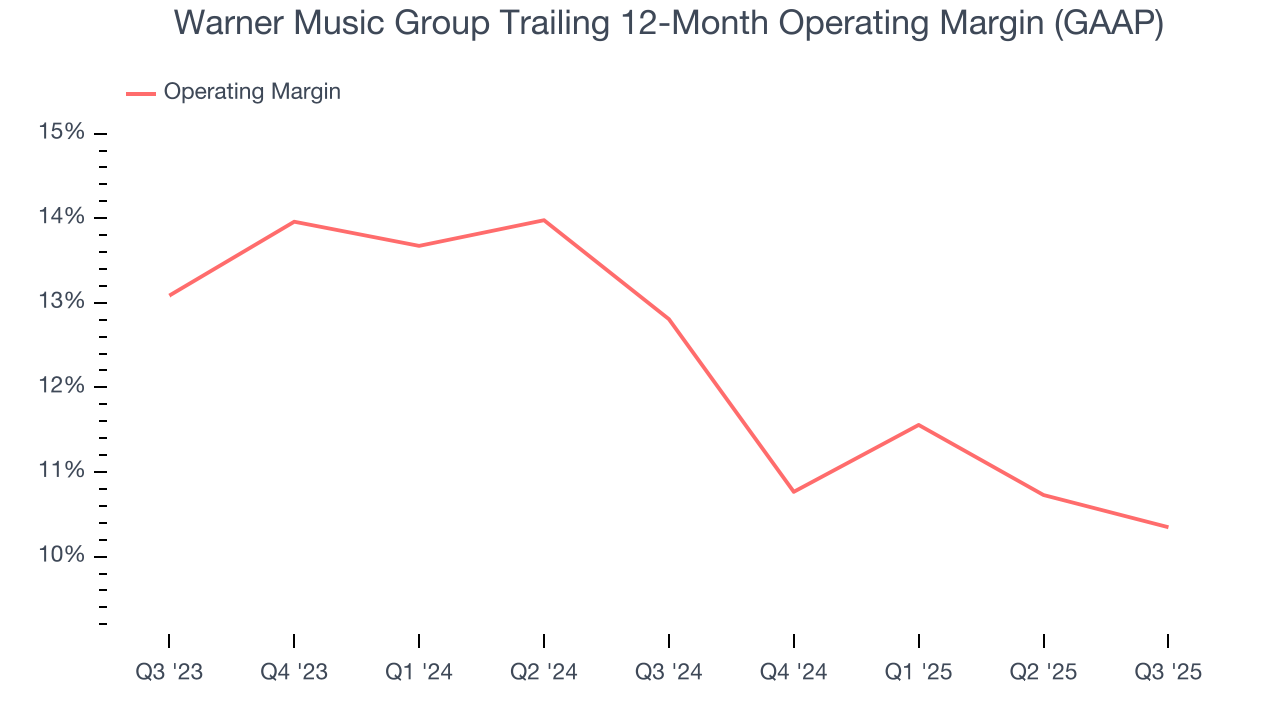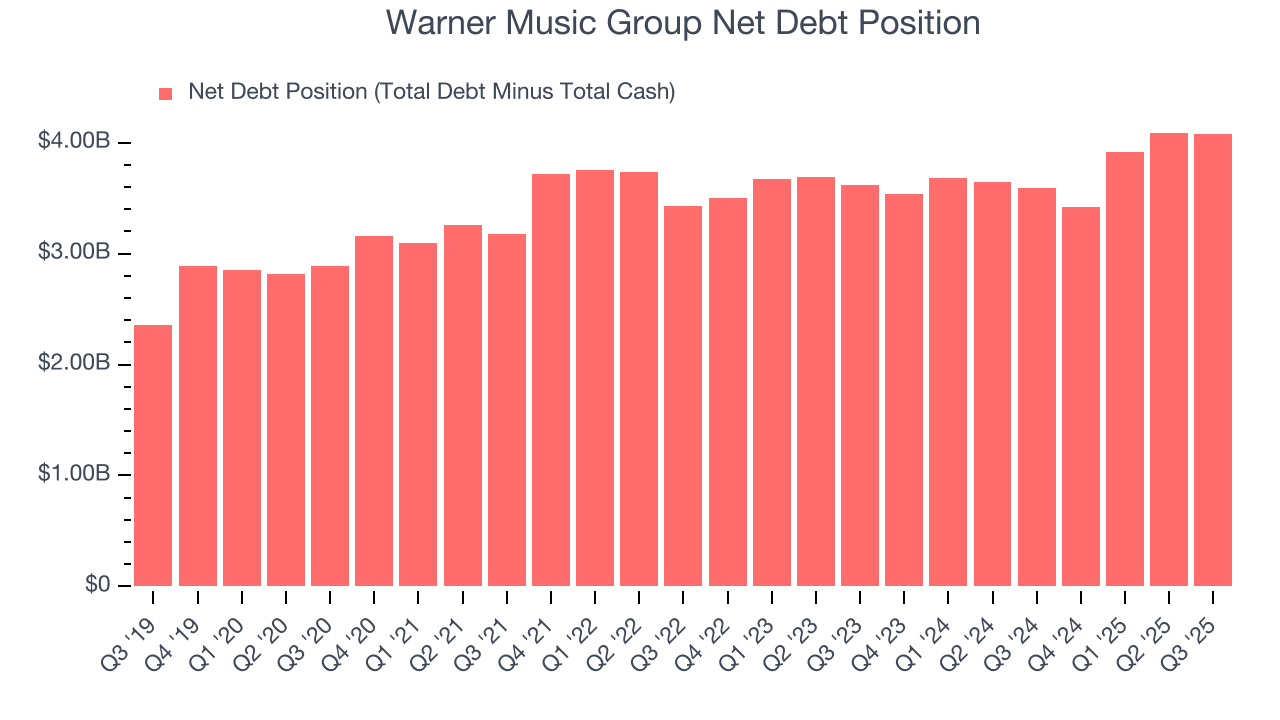
Warner Music Group (WMG)
We wouldn’t recommend Warner Music Group. Its weak sales growth and low returns on capital show it struggled to generate demand and profits.― StockStory Analyst Team
1. News
2. Summary
Why We Think Warner Music Group Will Underperform
Launching the careers of legendary artists like Frank Sinatra, Warner Music Group (NASDAQ:WMG) is a music company managing a diverse portfolio of artists, recordings, and music publishing services worldwide.
- Sales trends were unexciting over the last five years as its 8.5% annual growth was below the typical consumer discretionary company
- Responsiveness to unforeseen market trends is restricted due to its substandard operating margin profitability
- Poor free cash flow generation means it has few chances to reinvest for growth, repurchase shares, or distribute capital


Warner Music Group’s quality is insufficient. There are more appealing investments to be made.
Why There Are Better Opportunities Than Warner Music Group
High Quality
Investable
Underperform
Why There Are Better Opportunities Than Warner Music Group
Warner Music Group’s stock price of $27.85 implies a valuation ratio of 18.2x forward P/E. Warner Music Group’s valuation may seem like a bargain, especially when stacked up against other consumer discretionary companies. We remind you that you often get what you pay for, though.
Our advice is to pay up for elite businesses whose advantages are tailwinds to earnings growth. Don’t get sucked into lower-quality businesses just because they seem like bargains. These mediocre businesses often never achieve a higher multiple as hoped, a phenomenon known as a “value trap”.
3. Warner Music Group (WMG) Research Report: Q3 CY2025 Update
Global music entertainment company Warner Music Group (NASDAQ:WMG) reported Q3 CY2025 results beating Wall Street’s revenue expectations, with sales up 14.6% year on year to $1.87 billion. Its GAAP profit of $0.21 per share was 38.7% below analysts’ consensus estimates.
Warner Music Group (WMG) Q3 CY2025 Highlights:
- Revenue: $1.87 billion vs analyst estimates of $1.69 billion (14.6% year-on-year growth, 10.8% beat)
- EPS (GAAP): $0.21 vs analyst expectations of $0.34 (38.7% miss)
- Adjusted EBITDA: $405 million vs analyst estimates of $373.5 million (21.7% margin, 8.4% beat)
- Operating Margin: 7.7%, down from 8.8% in the same quarter last year
- Free Cash Flow Margin: 10.9%, down from 16.6% in the same quarter last year
- Market Capitalization: $15.9 billion
Company Overview
Launching the careers of legendary artists like Frank Sinatra, Warner Music Group (NASDAQ:WMG) is a music company managing a diverse portfolio of artists, recordings, and music publishing services worldwide.
Warner Music Group was founded to support artists and capitalize on the digital evolution of music distribution. The company strives to connect artists' creative work with audiences globally by providing a link between them and the market, giving artists the resources needed to broadcast to an international audience.
The company's revenue streams are diverse, encompassing sales of music in various formats, streaming services, and publishing rights. Warner Music Group's business model is anchored in content production, artist promotion, and expansive distribution networks with businesses such as Apple Music.
This approach not only extends the company's reach but also resonates with artists seeking a dynamic platform and professional marketing. In the absence of intermediaries like Warner Music Group, undiscovered artists would likely remain undiscovered as it’s extremely difficult to stand out in the music industry without big names backing you.
4. Media
The advent of the internet changed how shows, films, music, and overall information flow. As a result, many media companies now face secular headwinds as attention shifts online. Some have made concerted efforts to adapt by introducing digital subscriptions, podcasts, and streaming platforms. Time will tell if their strategies succeed and which companies will emerge as the long-term winners.
Competitors in the music industry include Universal Music Group (ENX:UMG), Sony Music Entertainment (owned by Sony, NYSE:SONY), and Spotify Technology (NYSE:SPOT).
5. Revenue Growth
A company’s long-term sales performance is one signal of its overall quality. Even a bad business can shine for one or two quarters, but a top-tier one grows for years. Over the last five years, Warner Music Group grew its sales at a sluggish 8.5% compounded annual growth rate. This was below our standard for the consumer discretionary sector and is a poor baseline for our analysis.

Long-term growth is the most important, but within consumer discretionary, product cycles are short and revenue can be hit-driven due to rapidly changing trends and consumer preferences. Warner Music Group’s recent performance shows its demand has slowed as its annualized revenue growth of 5.4% over the last two years was below its five-year trend. 
Warner Music Group also breaks out the revenue for its most important segments, Recorded Music and Music Publishing, which are 82.1% and 18% of revenue. Over the last two years, Warner Music Group’s Recorded Music revenue (new music production) averaged 4.6% year-on-year growth while its Music Publishing revenue (royalties from catalog music) averaged 9.9% growth. 
This quarter, Warner Music Group reported year-on-year revenue growth of 14.6%, and its $1.87 billion of revenue exceeded Wall Street’s estimates by 10.8%.
Looking ahead, sell-side analysts expect revenue to grow 2.9% over the next 12 months, a slight deceleration versus the last two years. This projection is underwhelming and indicates its products and services will see some demand headwinds.
6. Operating Margin
Warner Music Group’s operating margin has been trending down over the last 12 months, but it still averaged 11.6% over the last two years, decent for a consumer discretionary business. This shows it generally does a decent job managing its expenses.

This quarter, Warner Music Group generated an operating margin profit margin of 7.7%, down 1.1 percentage points year on year. This reduction is quite minuscule and indicates the company’s overall cost structure has been relatively stable.
7. Earnings Per Share
We track the long-term change in earnings per share (EPS) for the same reason as long-term revenue growth. Compared to revenue, however, EPS highlights whether a company’s growth is profitable.
Warner Music Group’s full-year EPS flipped from negative to positive over the last five years. This is encouraging and shows it’s at a critical moment in its life.

In Q3, Warner Music Group reported EPS of $0.21, up from $0.08 in the same quarter last year. Despite growing year on year, this print missed analysts’ estimates, but we care more about long-term EPS growth than short-term movements. Over the next 12 months, Wall Street expects Warner Music Group’s full-year EPS of $0.70 to grow 98.1%.
8. Cash Is King
If you’ve followed StockStory for a while, you know we emphasize free cash flow. Why, you ask? We believe that in the end, cash is king, and you can’t use accounting profits to pay the bills.
Warner Music Group has shown mediocre cash profitability over the last two years, giving the company limited opportunities to return capital to shareholders. Its free cash flow margin averaged 9%, subpar for a consumer discretionary business.

Warner Music Group’s free cash flow clocked in at $203 million in Q3, equivalent to a 10.9% margin. The company’s cash profitability regressed as it was 5.8 percentage points lower than in the same quarter last year, but it’s still above its two-year average. We wouldn’t read too much into this quarter’s decline because investment needs can be seasonal, causing short-term swings. Long-term trends are more important.
Over the next year, analysts predict Warner Music Group’s cash conversion will improve. Their consensus estimates imply its free cash flow margin of 8% for the last 12 months will increase to 10.8%, it options for capital deployment (investments, share buybacks, etc.).
9. Return on Invested Capital (ROIC)
EPS and free cash flow tell us whether a company was profitable while growing its revenue. But was it capital-efficient? A company’s ROIC explains this by showing how much operating profit it makes compared to the money it has raised (debt and equity).
Warner Music Group historically did a mediocre job investing in profitable growth initiatives. Its five-year average ROIC was 14%, somewhat low compared to the best consumer discretionary companies that consistently pump out 25%+.

We like to invest in businesses with high returns, but the trend in a company’s ROIC is what often surprises the market and moves the stock price. Unfortunately, Warner Music Group’s ROIC averaged 1.1 percentage point decreases over the last few years. Paired with its already low returns, these declines suggest its profitable growth opportunities are few and far between.
10. Balance Sheet Assessment
Warner Music Group reported $532 million of cash and $4.61 billion of debt on its balance sheet in the most recent quarter. As investors in high-quality companies, we primarily focus on two things: 1) that a company’s debt level isn’t too high and 2) that its interest payments are not excessively burdening the business.

With $1.44 billion of EBITDA over the last 12 months, we view Warner Music Group’s 2.8× net-debt-to-EBITDA ratio as safe. We also see its $162 million of annual interest expenses as appropriate. The company’s profits give it plenty of breathing room, allowing it to continue investing in growth initiatives.
11. Key Takeaways from Warner Music Group’s Q3 Results
We were impressed by how significantly Warner Music Group blew past analysts’ revenue expectations this quarter. We were also glad its Recorded Music revenue outperformed Wall Street’s estimates. On the other hand, its EPS missed. Overall, this print had some key positives. The stock remained flat at $30.60 immediately after reporting.
12. Is Now The Time To Buy Warner Music Group?
Updated: December 4, 2025 at 10:04 PM EST
Before deciding whether to buy Warner Music Group or pass, we urge investors to consider business quality, valuation, and the latest quarterly results.
We cheer for all companies serving everyday consumers, but in the case of Warner Music Group, we’ll be cheering from the sidelines. First off, its revenue growth was weak over the last five years, and analysts expect its demand to deteriorate over the next 12 months. And while its spectacular EPS growth over the last five years shows its profits are trickling down to shareholders, the downside is its projected EPS for the next year is lacking. On top of that, its relatively low ROIC suggests management has struggled to find compelling investment opportunities.
Warner Music Group’s P/E ratio based on the next 12 months is 18.2x. While this valuation is fair, the upside isn’t great compared to the potential downside. There are more exciting stocks to buy at the moment.
Wall Street analysts have a consensus one-year price target of $38 on the company (compared to the current share price of $28.04).
Although the price target is bullish, readers should exercise caution because analysts tend to be overly optimistic. The firms they work for, often big banks, have relationships with companies that extend into fundraising, M&A advisory, and other rewarding business lines. As a result, they typically hesitate to say bad things for fear they will lose out. We at StockStory do not suffer from such conflicts of interest, so we’ll always tell it like it is.









